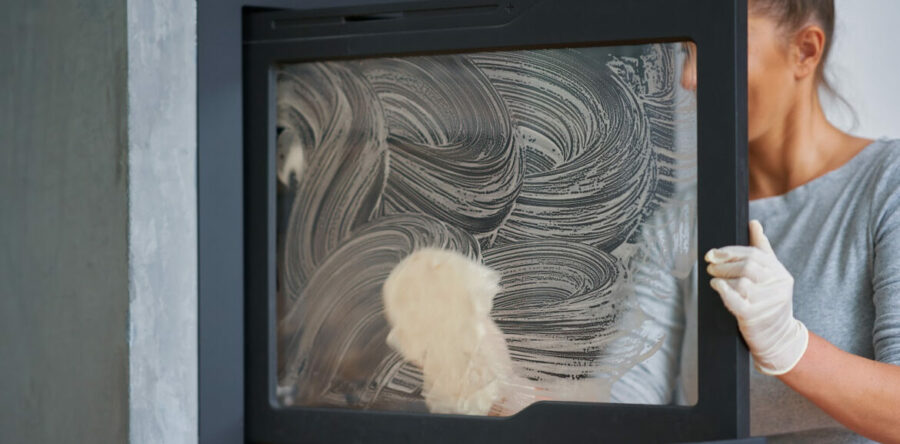Once or twice a year, it’s a good idea to clean the glass on your fireplace, stove or insert. So just spray on a little window cleaner and wipe it off, right? Cleaning fireplace glass isn’t a big deal. Wrong! There are right and wrong ways to clean the glass on your fireplace. Here are some do’s and don’ts. Taking a few minutes to read this article is worth your time and could even save you several hundred dollars!
TEMPERED VS. CERAMIC GLASS
The glass in your fireplace is not like the glass in the windows of your home or car. Fireplaces have either tempered glass or ceramic glass. Both can tolerate high temperatures. However, ceramic glass is much more resistant to higher temperatures and quick thermal changes. Ceramic glass is stronger than tempered glass of the same thickness.
Ceramic glass can handle temperatures of 1000°F (538˚C). It’s regularly found on wood burning stoves, inserts and fireplaces. Those gas models with larger burners and higher heat outputs will be equipped with ceramic glass. Other gas fireplaces come with tempered glass. Bi-fold doors on inexpensive wood burning fireplaces are usually tempered glass.
It doesn’t matter what kind of glass you’re cleaning. Both types will get dirty and either type of glass will break if you’re not careful. Tempered glass is less expensive than ceramic. The ceramic glass on a wood or gas fireplace, stove or insert can easily cost $200-$300 or more to replace, so easy does it!

Wood Insert Astra 38 Supreme
GETTING STARTED
The first thing you’ll want to do, is determine if cleaning the inside of the glass is a project you want to tackle. If the answer is “no”, your WE LOVE FIRE® dealer can clean the glass during an annual routine service call. However, if this is something that you’re okay with tackling yourself, call your WE LOVE FIRE® dealer or plan a trip to the showroom to get what you’ll need. WE LOVE FIRE® dealers keep fireplace glass cleaner in stock. One is designed for gas appliances, and another type is designed for woodburning appliances. Do not use a regular window cleaner or spray. It’s not particularly expensive, so spend the money for the correct product. It will make this job considerably easier. It doesn’t take much, so a bottle will likely last a few years!
REMOVING THE GLASS
The glass on your gas fireplace can be removed. Each model is a little different, so dig out your owner’s manual for the correct procedure on how to detach it. Typically, there are some sort of clips or spring-loaded clamps that allow it to be quickly removed. Be careful not to bump the logs once the glass is off. [Side bar: never rearrange or reorganize the logs on your gas fireplace. There are very specific positions the logs must be in when the fireplace is operating.]
The glass door on your wood burning stove, insert or fireplace can just be swung wide open for cleaning purposes.
SIMPLY FOLLOW THE DIRECTIONS!
You’ll want to put the glass from your gas fireplace on an old towel, flat on the floor. The glass and its frame are large, so be careful while you’re cleaning it. Next, just follow the directions on the cleaner. Most glass cleaners for gas fireplaces come as a semi-paste, almost similar to a car wax. Read and follow the directions. But basically, it’s: rub it on and polish and buff it with a clean, soft rag.
For wood-burning appliances, put down rags or newspapers under the door. Most wood burning glass cleaners come in a spray bottle. Again, just follow the directions on the bottle, but this is normally sprayed on and wiped off with paper towels or a rag. Often the cleaner will run down the glass and drip onto the floor. Be sure to protect the floor by laying down old towels, rags or a drop cloth of some kind.
INSPECT THE GASKET MATERIAL
While you’re cleaning the glass, it’s always a good idea to inspect the gasket that seals the glass to the door or front. On a wood burning appliance, the door gasket prevents air from leaking between the door and the front of the stove or fireplace. If a gasket is showing signs of wear, replace it. If you’re noticing reduced burn times on a load of wood or seeing black streaks on the glass, it’s likely that the door gasket needs to be replaced. Your WE LOVE FIRE® expert has gasket material in several sizes in stock.
DO NOT SCRAPE
One thing that you never want to do is to take a razor blade to ceramic glass. There is a microscopic coating of polycrystalline structures on ceramic glass. A razor blade can actually get under this very thin coating and remove it or cause it to peel or chip. Again, ceramic glass is expensive to replace, so use the cleaner as the directions advise and leave the single edged razor blade in the tool box.
SO, WHY BOTHER?
You might ask yourself that question. Why bother with cleaning the glass at all? It’s just going to get dirty again, right?
I guess that’s true. However, keeping the glass clean is a good maintenance habit and will go a long way to helping you and others enjoy the beauty of the fire.
In a gas fireplace, stove or insert the inside of the glass will get dirty over time. Soot and small particles from combustion will begin to accumulate on the glass. Odds are, you won’t even notice it, until you remove the glass and clean it! It’s like the inside of your car’s windshield. You don’t really notice how dirty it is until you wipe off that fine film. And then, presto! You appreciate how clean glass improves your vision while driving.
In a wood appliance, the coal bed and flame patterns of the fire are constantly changing. It can be so relaxing and enjoyable to see a slow, controlled burn and a clean, clear view of the fire. And keeping your glass clean only takes a few minutes.











0 Responses